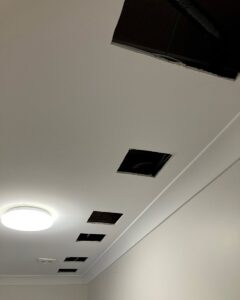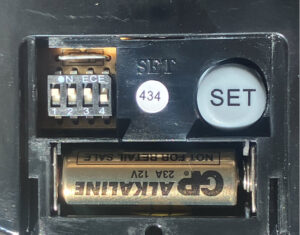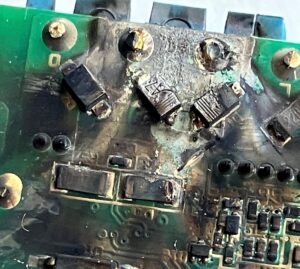In What is this Home Automation stuff anyway? i mentioned the primitive electrical state of our new home. Whilst there were separate circuits for the fridge and wall oven, the rest of the two-storey house was fed with 1 lighting circuit and 1 power circuit per floor. Individual residual current breakers? No chance.
The lighting was dismal too. The upstairs rooms all had ceiling fans with no two alike. Some were AC, the rest DC, and all had some kind of inbuilt “light”, with luxurious on/off control. I’m using quotes there because they didn’t do much of a job of illuminating the room. The fans went, replaced by MATCHING (heaven forbid!) DC devices, however that left us with even less light upstairs.
We’d lived in our last home for just shy of 20 years, and I’d built up quite the well-established Home Automation setup, based upon Clipsal’s “C-Bus” building management platform, so some degree of Home Automation (herein “HA”) was a given for the new place. In that 20 years, Clipsal’s been bought out by Schneider Electric, and to my mind poor C-Bus has been largely left to rot. Sure, the switches have been updated into the current plate designs, but there’s not been much movement beyond that.
So what’s KNX?
Researching my options I found that C-Bus has what looks to me like an identical twin called “KNX”, but they’d been separated at birth.
Per my simile, both twins appear to share the same genetic makeup, and that’s reflected in the almost identical architecture: a ~30V DC power supply feeding a twisted-pair bus to which are connected input (“sensor” in KNX parlance) and output devices (KNX “actuators”), with miscellaneous support devices adding USB or Ethernet connectivity, to run advanced logic or serve web-pages for remote control.
The big difference between both is that C-Bus has one manufacturer globally – Clipsal in Australia – whereas the global knx.org parent oversees 500 member companies in 190 countries making north of 8,000 KNX-certified “widgets”, all of which play nicely together and are programmed with the one PC-based application.
Check out its Wikipedia page for lots more info, or the 24-page “KNX Basics” PDF if you want to get a little deeper.
Why KNX?
There are lots of factors that helped make this decision, and our history with C-Bus as an equivalent platform would have provided a predisposition.
I don’t think any single point below is the silver bullet, but when all were assessed the answer became obvious.
| TL;DR: Jump to the Summary for a quick collation of the key points. |
Because we can
- Because we can afford it KNX (like C-Bus before it) is pricey to install. You might pay 5 times more per channel for a dimmer when compared to the little plugin or wire-in units in the market, however I believe it’s worth it for a range of reasons, with reliability at the top of that list. I deem it *essential* to have services like lighting controlled by a platform that’s secure and reliable, and KNX ticks that box. I expand on some of these points later in this post.
- Because we can install it The building is a 15yo project home, across two levels. We have good access to the roof void and easy cavity drops down the walls for switches – to upstairs at least, but that’s where the current focus is. As we expand it in later years I expect to have to punch a few holes in the Gyprock [aka gib, drywall] to run in all the required cables – but I’ll attempt to use the existing cabling for pullbacks as a first course of action.

The aircon guys had to bash a few holes in the ceiling so they could get their plumbing through all the timber I-beams [aka SmartJoists]. I used this opportunity to pre-cable some future downstairs lighting and relay circuits & run the vibrant green KNX bus cable.
It needs to be reliable
Over time the house’s entire lighting will be controlled by KNX – and all of upstairs’ lighting already is. And when you flick a light switch, the light just HAS to come on.
Other devices will come under KNX control too, including various elements of heating, cooling, blinds and fans. Some of these are convenience features, but others will play a more important role.
I’m viewing “reliability” in two ways: it needs to do what it’s meant do consistently, on command, not be flaky or unpredictable. It also needs to not blow up or otherwise fail should (say) a lamp blow, or the temperature get a little hot.
Bulletproof commercial platforms like C-Bus and KNX meet this criteria for me.
I’m pretty sure Sydney’s new International Convention Centre (ICC) didn’t choose KNX because it’s unreliable or untrustworthy – completely the opposite. [Reference]
The “5x” dimmer premium I referenced earlier buys you devices built with PLENTY of headroom in their component specifications, or perhaps higher-spec’d industrial-grade components that will tolerate harsh operating environments. Lesser platforms are built to a price, and that’s often reflected in their long-term survival rate, or lack thereof.
I took cheap Wi-Fi devices for a trial run as part of my research into our future HA platform. This is what’s left of a 1-channel dimmer module that failed and went fully short-circuit across the mains. And the Internet is full of pictures of modules like this where the magic smoke has been set free.
In over 20 years of C-Bus I needed to replace two devices: intense rain managed to travel up-hill to kill one, and the second was done in by cockroaches. I need that level of reliability in the HA platform here.
When we eventually sell this place, the new owners are going to inherit a stable, reliable, secure, supportable HA platform.
Wired over wireless
Some might think I’m veering into old man/tinfoil hat territory here, but I have a healthy distrust of wireless devices: there’s just so much more to go wrong.
Have you ever tried nuking something in the microwave oven while using your Bluetooth headset? I’m pretty sure that didn’t go well for you. The 2.4GHz frequency range they share makes those mutually incompatible, so you’ll not want Blueooth IoT/HA devices anywhere near the kitchen.
Ditto for ZigBee, which also shares 2.4GHz.
Other things to go wrong with wireless setups:
- the failure of a critical participant in your meshed network causing everything downstream to die.
- channel clash with your neighbours. (True story: I recently spent a solid week trying to debug an issue with a flaky Raspberry Pi Access Point only for it to turn out that the channel I’d carelessly chosen for it clashed with the DIFFERENT channel we were using for the in-house Wi-Fi).
- *device* clash with your neighbours. It’s rare but still possible in 2022 to buy devices that won’t let you choose a channel or otherwise customise your deployment, requiring yours to be the only instance of this device within radio range.
- authentication problems. Where matching DIP switches is your only means of authenticating transmitter to receiver, it’s possible that the neighbour’s remote control might accidentally (or otherwise) operate YOUR device!

Here’s one of our fan remotes: 4 DIP switches = 16 combinations. OK, the mischief you can cause here isn’t all that great, but how secure is the remote control to your garage? - lots of IoT/HA devices won’t run on your 5GHz Wi-Fi network, forcing you back to 2.4GHz and channel clash and/or the microwave oven problem.
- drive-by sniffing. You mightn’t think you’re big enough or interesting enough for someone to care, but the more dense the population in which you live, the more likely an opportunist is going to sniff something you’d rather they didn’t.
- see Security, below.
Other benefits of being wired are:
- easier fault-finding. You can easily buzz out a cable for shorts and opens, and physically disconnect branches or cable segments to isolate faults.
Security
A wired network where the cabling doesn’t extend beyond the building’s perimeter is ALWAYS going to be more secure than wireless.
The more wireless devices you have and the more vendors represented significantly increases your security risk from zero-days and known, patched vulnerabilities that you don’t even realise you need to address! Update, update, update!
My friend @Techydude says I don’t think this can be overstated; most people still don’t realise that all these gadgets are small computers, frequently using open-source software libraries that are shared extensively across the software developer ecosystem. “Open-source” has been demonstrated to be no more or less secure than closed-source, with now countless examples of open-source projects that’ve had gobsmackingly bad vulnerabilities not only discovered, but exploited by criminals, despite that open-source code being there for anyone and everyone to “review and make better”, some whose vulnerabilities have been present for a decade or more before discovery and patching.
And then there’s the whole issue of how long it takes for patched software libraries to be updated into new firmware for your HA device, and whether your HA device installs these firmware updates itself, or requires the harried HA device owner to somehow become aware there’s updates needing to be installed, and then making the time to install them.
One over-arching principle of “good infosec” is that the more software is in a system, the less secure it is (i.e. a greater “attack surface”), and wireless communication protocol stacks tend to be quite large and complex lumps of Someone Else’s Code, inserted into the overall (HA) product to achieve a valuable feature for the least amount of engineering effort by the developers of the HA product.
Longevity
The more you invest in a technology, the longer you’re going to want it around for.
I’m expecting KNX to be still here in 10 years. As a platform it’s 30+ years old now, still evolving and growing, and the association has a HUGE base of big member companies the likes of ABB, Schneider Electric and Siemens to name just three.
It’s not UN-reasonable to expect that not all the manufacturers of the bits I’ve installed *will* be here in a decade, but should their particular device fail, I have a great deal of confidence that I’ll be able to *easily* replace it with a drop-in equivalent from another manufacturer of certified KNX components.
Hardwired over plugin
Lots of plugin HA solutions – *especially* “smart” light bulbs – have a critical weakness: the light switch next to the door. That needs to be left permanently on so the device gets its power and is able to receive the wireless commands to control it. All you need is a confused visitor or for you to absent-mindedly flick the light switch off upon leaving the room and – bam – not only does that room drop offline (from a management, remote control and visibility standpoint) but so will any meshed downstream devices that were relying on it.
Plugin devices are also more easily knocked out of wall outlets, and are also more likely to foul or be damaged by nearby furniture.
Yes, I grant you, plugin devices are INCREDIBLY flexible: you can put them where-ever there’s wireless coverage and a mains socket/outlet of some type.
100% on-prem, with no cloud subscription or companies to go bankrupt
Hands up all of you who’ve bought some product with an essential cloud-based management component – usually an app for your phone – and the company’s later gone bust and left you with an expensive paperweight? Yeah, us too. Twice shy, we no longer buy products where there’s a requirement for web-based control/management and no means to DIY if they jack the prices or go bust. So on-prem it is.
Our KNX deployment all runs totally inside the house. If I want to control it remotely I can connect via VPN, but any security weakness there is the VPN’s and not the HA platform and its myriad devices.
Down the track I might decide to add some cloud-hosted voice control, however I’m not rushing into that one. The option’s there if I (<cough> we) choose, so going with KNX doesn’t lock us out of that. Thankfully the option exists to also do this locally! [Ref. 1]
Privacy
Another benefit of being 100% on-prem is a greater level of privacy, although this overlaps with Security too. Are you REALLY comfortable using a cloud-based Home Automation platform that knows whether you’re home or not? What other information could you be accidentally leaking off-site that could be used against you by someone with nefarious intent?
I can program/manage it myself
This one isn’t for everyone, but having administered our own C-Bus setup for decades, I obviously wanted the flexibility to be able to grow and tweak it myself without needing to engage a third party.
Having decided on KNX I ordered my initial hardware items and booked myself into the KNX Basic Certification Course. The plan was I’d complete the course and then return home to put my new knowledge into practice.
Covid had other ideas, and I was forced to postpone my participation in the course until its next delivery three months later. By that time I had a working installation at home and had already added a few more bits of hardware. I’d been able to configure it after having completed the free “eCampus” ETS course [you need a myKnx login for that one], watched some YouTube videos and vendor training webinars – and yes, coughed up for a licence dongle that the 1990’s is going to want back soon.
There was still value to be had in the official training, and I returned from the course needing to tear apart much of my initial config and rebuild it to be more standards-compliant and future-proofed. [I’d mucked up my Group Address structure and painted myself into a corner.]
Whilst it’s not an official benefit of the certification program, my supplier also kindly offers a “trade price” discount to those who are certified, and so over time the cost of the training will be recouped through savings in the price of additional hardware.
Other considerations
- There’s an app for that Yup: a native app for my phone, without needing to hop via the cloud. I’m using the GIRA X1 module for this, but there are many others available. It also adds logic, timers, and lets you drive the house from a browser too.
- The sheer VASTNESS of the ecosystem KNX manufacturers are offering every possible sensor and actuator under the sun, and devices that talk to air-conditioners or control protocols like BACnet, DMX, RS485 etc. This lets KNX be the “common denominator”, the foundation I’m using for Home Automation upon which I can add all sorts of interfaces later.
- It needs to be guest-friendly I’ve seen some scary HA deployments. My goal is that a guest needs to be able to go to the bathroom without needing a laminated instruction card or prior training course to turn the light on. Our choice of simple, recognisable light switches throughout the house conceals the underlying automation from guests.
- It’s supportable after we leave KNX is a well-established commercial platform with plenty of experienced, certified people who can take over support when we eventually sell the house – we just need to provide the “project file” when we depart and the info and config’s all there.
Summary
Key points
- Because we can We can afford to do this, and the building is largely conducive to the installation of a wired deployment.
- Reliability I’m not going to be here 100% of the time to babysit the home automation – and you know how appliances can sense when you’re going on holidays? KNX isn’t like that. It’s commercial-grade, and yes that comes at a price.
- A familiar user-interface The light switches are all instantly recognisable to a visitor and easily controlled. All the “cleverness” either happens automatically, or is tucked away in a dedicated app, web-page or (eventually) flush-mounted tablet on the wall.
- Longevity KNX as a platform will still be here in 10 years time, so I’m confident we’re future-proofed against single-vendor failures.
- Wired A wired deployment brings improved reliability and security.
- Secure No constant need to be updating the firmware in wireless devices to address their latest security exploit.
- Totally on-prem No reliance on the Internet, no cloud service to pay for, and one less hole in the firewall.
- Private We’re not broadcasting our presence or absence to cloud-based services.
- I can DIY the config You can too – and you don’t need to pay for the certification if you don’t want to.
- The ecosystem is huge. No need to bridge multiple protocols together and struggle to get everything talking together – and keep that happening through every firmware update.
- Supportable It’s a well-known platform with plenty of people who can support it ongoing.
I acknowledge our choice is VERY skewed towards someone with the cash to spend who happens to own their own home, or be in the long, slow process of paying it off.
If you’re renting and want this sort of control over your building then of course you’re forced into wireless and plugin networks of necessity, and I get that.
The above is for us a fairly black-and-white justification for a wired KNX deployment.
In this post I wanted to capture my thought processes and air the sorts of potential weaknesses of an alternative wireless, “consumer-grade” Home Automation deployment. The goal was initially to save me telling the same story over and over again to our curious techy friends who were wondering what this “KNX” was, but of course it has much broader potential and will hopefully help guide others now in the position we were six months ago.
If you’re very hands-on and are OK with various pitfalls I’ve raised above, then that’s great. Fellow Aussie and MVP Troy Hunt is one of those people, and his convoluted journey is one worth reading if you’re undecided.
As I said at the outset, bulletproof reliability is by far and above the most important factor here, and so far our 3-month-old KNX deployment (as at September 2022) is delivering that.
In the coming months I’ll be blogging more details about what we’ve done here, and there’s lots planned, limited only by my time, budget, and creativity. (OK, and sometimes permission.)
In the works is a detailed look at our BrightGreen “DayShift” D700 “Tunable White” LED downlights. These use KNX to imperceptibly change their colour temperature as the day progresses, from a bright melatonin-suppressing 5800°K to wake you in the morning, down to a sleep-inducing 2800°K in time for bed. Another will document how I’ve integrated Stream Deck and web-control into the building.
Where to Next?
If the above inspires you to join me on this journey, check out some of the resources listed below – and of course check back here regularly.
I buy all my kit from Ivory Egg, which has a presence in Australia, New Zealand and the UK. Peruse the store for a look at the vast range of KNX products they sell, all certified for those markets.
If you’re not the type to DIY (or don’t have the required legal approvals for your market) you’ll need an integrator if you want to get on-board, and if you’re in one of the above countries Ivory Egg should be able to make an introduction – or “find a partner” on the KNX website and flush out one of the 100,000 certified professionals world-wide.
Resources
- The parent organisation’s website.
- Find an in-country national group or Userclub.
- Read some more about the KNX standard on Wikipedia.
- Go a little deeper with the KNX Basics PDF.
- Take the free online course at my.knx.org – there’s a discount for the ETS software if you pass!
- Join the KNX Global group on Facebook,
- … or the German-language support forum.
(Have I missed any must-haves?)
References
1. Everything Smart Home on YouTube: “Local Voice Control With Home Assistant Just Got Easier!”
Revision History
9th October 2022: Added the References heading and Ref1.
8th September 2022: This is the initial release.
– G.






Great write-up and perspective Greig, thanks for sharing. We look forward to helping you as you develop your KNX system!
Thanks Ed.
It’s growing at a ‘viral’ rate already – and I say that having not long climbed down from the latter attempting the cavity drop to the Theben daylight/temp sensor.
Stay tuned – lots more KNX-related blog posts to come.
– Greig.